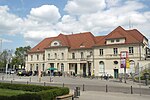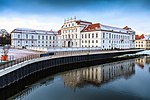NKVD special camp Nr. 7

NKVD special camp Nr. 7 was a NKVD special camp that operated in Weesow until August 1945 and in Sachsenhausen from August 1945 until the spring of 1950. It was used by the Soviet occupying forces to detain those viewed as enemies of the people by the Soviet regime. In August 1945, the Special Camp Nr. 7 was moved to Sachsenhausen, the area of the former Nazi Sachsenhausen concentration camp. Under the NKVD, Nazi functionaries were held in the camp, as were political prisoners and inmates sentenced by the Soviet Military Tribunal. By 1948, Sachsenhausen, now renamed Special Camp No. 1, was the largest of four special camps in the Soviet occupation zone. The 60,000 people interned over five years included 6,000 German officers transferred from Western Allied camps.After the fall of East Germany it was possible to do excavations in the former camps. In Sachsenhausen the bodies of 12,500 victims were found, mostly children, adolescents and elderly people.By the time the camp closed in the spring of 1950, at least 12,000 had died of malnutrition and disease.
Excerpt from the Wikipedia article NKVD special camp Nr. 7 (License: CC BY-SA 3.0, Authors, Images).NKVD special camp Nr. 7
Straße der Nationen,
Geographical coordinates (GPS) Address Website Nearby Places Show on map
Geographical coordinates (GPS)
| Latitude | Longitude |
|---|---|
| N 52.765833333333 ° | E 13.264166666667 ° |
Address
Gedenkstätte und Museum Sachsenhausen
Straße der Nationen 22
16515 , Lehnitz
Brandenburg, Germany
Open on Google Maps








